To fix scratches on a wood floor, sand the affected area and apply a matching wood stain. Wood floors can add warmth and beauty to any space, but scratches can detract from their appearance.
If you’re wondering how to fix scratches on a wood floor, there’s a simple solution. By sanding the scratched area and applying a matching wood stain, you can restore the floor’s original beauty. We will walk you through the steps to fix scratches on your wood floor.
With a little bit of time and effort, your wood floor will look as good as new. So let’s get started!
Assessing The Damage
Assessing the damage and fixing scratches on wood floors is easier than you think. Follow our expert tips and tricks to bring back the natural beauty of your wood flooring without hassle.
Wood floors are an elegant addition to any home, but scratches can take away from their beauty. When it comes to fixing scratches on wood floors, assessing the damage is the crucial first step. Before diving into the repairs, it’s important to identify the types of scratches, understand their depth, and determine the extent of the damage.
This assessment will ensure that you take the right approach to restoring your wood floors. In this section, we will explore these aspects in detail.
Identifying The Types Of Scratches:
- Surface scratches: These are minor scratches that only affect the topmost layer of the wood finish. They are usually shallow and can be easily resolved with simple repair techniques.
- Deep scratches: Unlike surface scratches, deep scratches penetrate the wood, affecting the underlying layers. These require more comprehensive repair solutions.
Understanding The Depth Of The Scratches:
Determining the depth of the scratches is essential in order to choose the appropriate repair method. Here are some ways to assess the depth of the scratches:
- Visual inspection: Examine the scratches closely to determine if they are shallow or deep. Light scratches may appear more like surface abrasions, while deeper scratches tend to be more noticeable and may even reveal the raw wood beneath.
- Running your fingertip: Gently slide your fingertip over the scratched area. If the scratch can be felt with slight resistance, it may be a deeper scratch. If it is barely noticeable or feels smooth, the scratch is likely more superficial.
Determining The Extent Of The Damage:
Understanding the extent of the damage is crucial to establish the best course of action. Consider the following factors when determining the extent of the damage:
- Size of the scratch: Assess how wide and long the scratch is. Larger scratches may require more intensive repair methods.
- Number of scratches: Take note of the quantity of scratches on your wood floor. If there are only a few isolated scratches, individual repair techniques may be sufficient. However, if the scratches are numerous and cover a significant area, a more extensive restoration process might be necessary.
- Impact on the floor’s functionality and appearance: Evaluate how the scratches affect the overall look and functionality of the wood floor. Some scratches may be purely cosmetic and not impact the floor’s performance, while others may require immediate attention due to safety concerns or future damage risks.
By identifying the types of scratches, understanding their depth, and determining the extent of the damage, you’ll be equipped with the necessary knowledge to proceed with the most suitable repair methods. Assessing the damage is a crucial step towards successfully fixing scratches on wood floors and restoring their natural beauty.
Preparing The Wood Floor
Learn how to fix scratches on your wood floor with these simple steps. Preparing the wood floor is crucial for achieving a smooth and flawless finish.
To effectively fix scratches on a wood floor, proper preparation is key. By following these steps, you can ensure that your wood floor is ready for the repair process:
Cleaning the floor surface:
- Start by removing any loose debris or dirt from the floor. Sweep or vacuum the area to eliminate any particles that may interfere with the repair process.
- Use a microfiber cloth or mop to gently wipe down the floor surface. This will help remove any remaining dust or dirt and create a clean base for the repair.
- Inspect the floor for any sticky residue or stains. If necessary, use a gentle cleanser specifically designed for wood floors to remove the stubborn marks. Be cautious to avoid using harsh chemicals that can damage the wood.
- Wipe down the floor again using a damp cloth to ensure that it is thoroughly clean.
Removing any debris or loose dirt:
- Examine the scratched areas closely. Remove any loose splinters or debris that may have accumulated in the scratches. This will help create a smooth surface for the repair.
- Gently rub the scratched areas with a fine-grit sandpaper, moving in the direction of the wood grain. This will help smooth out any rough edges and create a seamless repair.
Ensuring the area is dry and free from moisture:
- Moisture can negatively affect the repair process and the overall condition of the wood floor. Ensure that the area is completely dry before proceeding.
- Use a fan or open windows to increase air circulation and aid in drying any damp areas.
- Avoid applying any repair products or treatments until the wood floor is completely dry. Moisture can interfere with the effectiveness of the repair and result in further damage.
Preparing the wood floor properly sets the stage for successful scratch repair. By cleaning the surface, removing any debris or loose dirt, and ensuring the area is dry, you can achieve optimal results and restore the beauty of your wood floor.
Diy Solutions For Minor Scratches
Learn how to fix minor scratches on your wood floor with these simple DIY solutions. Easily restore the beauty of your hardwood flooring with these effective tips.
Wood floors can add warmth and elegance to any space, but over time, scratches may appear from daily wear and tear. Luckily, there are simple and cost-effective DIY solutions to fix minor scratches and restore the beauty of your wood floor.
Whether you have shallow scratches, deeper ones, or just light surface scratches, we’ve got you covered. Read on to learn how to address each type of scratch and bring your wood floor back to its original glory.
Using A Wood Filler For Shallow Scratches
If your wood floor has shallow scratches that are not too deep, using a wood filler can be an effective solution. Follow these steps to fix the scratches:
- Thoroughly clean the scratched area using a soft cloth and a gentle wood cleaner.
- Prepare the wood filler according to the manufacturer’s instructions.
- Apply a small amount of wood filler directly onto the scratches using a putty knife.
- Smooth out the excess filler, ensuring it blends in with the surrounding area.
- Allow the filler to dry completely before sanding down any rough edges.
- Finally, apply a protective finish, such as polyurethane, over the repaired area for added durability and longevity.
Remember to choose a wood filler that matches the color of your wood floor for seamless results.
Applying A Matching Stain For Deeper Scratches
Deeper scratches require a different approach to restore the wood floor’s appearance. Here’s how you can fix them:
- Begin by cleaning the scratched area with a wood cleaner and a soft cloth.
- Carefully sand the scratched surface with fine-grit sandpaper to even out the damage.
- Once the scratches are smooth, clean away any dust or debris.
- Choose a stain that matches your wood floor’s color and test it in an inconspicuous area to ensure a proper match.
- Apply the stain to the scratched area using a clean cloth or a brush, following the manufacturer’s instructions.
- Allow the stain to dry fully before applying a thin coat of polyurethane to protect the repaired surface.
By applying a matching stain, you can effectively conceal deeper scratches and restore the original beauty of your wood floor.
Buffing Out Light Scratches With Steel Wool
For light surface scratches, buffing with steel wool can yield impressive results. Here’s how to go about it:
- Start by cleaning the scratched area with a wood cleaner and a soft cloth.
- Choose fine-grade steel wool (such as #0000) and rub the scratched surface gently in the direction of the wood grain.
- Continue to buff until the scratches become less noticeable or vanish completely.
- Wipe away any residue with a clean cloth.
- For an added protective layer, apply a wood floor polish or wax, following the product instructions.
Buffing out light scratches with steel wool is a quick and easy solution that can bring back the luster of your wood floor.
Remember, regularly cleaning and maintaining your wood floor can help prevent scratches. However, using these DIY solutions can effectively minimize the appearance of minor scratches and help extend the life of your cherished wood floor.
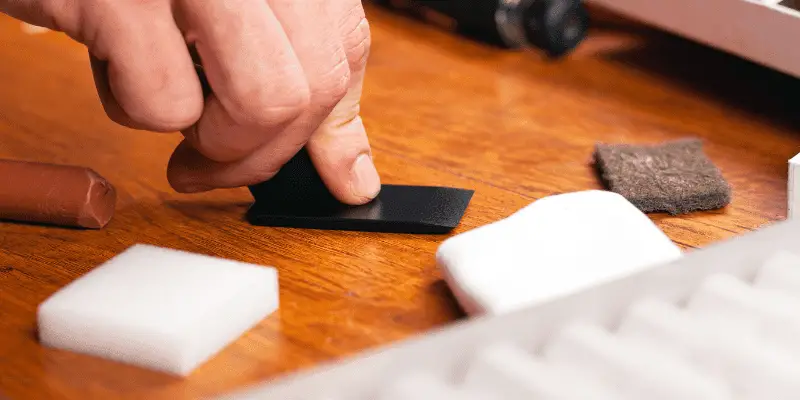
Professional Options For Deep Scratches
Fixing deep scratches on wood floors is a job best left to the professionals. With their expertise and specialized techniques, they can ensure that your floors are restored to their original beauty without further damage. Trust the experts to handle your wood floor repair needs.
Scratches on wood floors can be a real eyesore, but luckily there are professional options available for fixing deep scratches. Consulting with a wood floor specialist, discussing sanding and refinishing options, and getting an estimate for professional repair are all viable solutions to consider.
Let’s dive deeper into these professional options:
Consulting With A Wood Floor Specialist
- Reach out to a reputable wood floor specialist in your area for expert advice and guidance.
- A wood floor specialist can assess the extent of the damage and recommend the best course of action.
- They will be able to provide insights into the specific type of wood flooring you have and the most suitable repair options.
Discussing Sanding And Refinishing Options
- Sanding and refinishing is a popular method for fixing deep scratches in wood floors.
- The process involves removing the damaged surface layer of the wood and applying a fresh coat of finish to restore its appearance.
- Discuss with the specialist whether sanding and refinishing is a suitable option for your particular floor, taking into consideration factors such as the thickness of the wood and the depth of the scratches.
Getting An Estimate For Professional Repair
- Before committing to any professional repair, it’s essential to obtain an estimate from the wood floor specialist.
- This estimate should outline the cost of the repair, including materials and labor.
- Additionally, inquire about the timeframe for the repair to ensure it aligns with your schedule and expectations.
Remember, deep scratches on wood floors are best handled by professionals who possess the expertise and tools necessary for an effective and long-lasting repair. By consulting with a wood floor specialist, discussing sanding and refinishing options, and getting an estimate for professional repair, you can confidently address those unsightly scratches and restore your wood floor’s natural beauty.
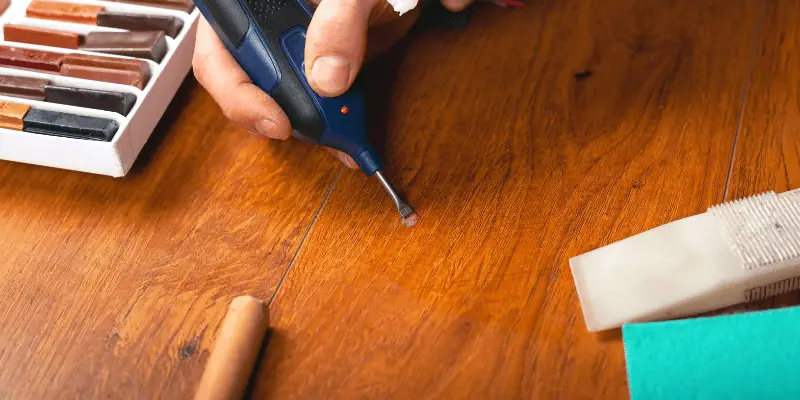
Preventing Scratches In The Future
To prevent future scratches on your wood floor, it’s important to take preventive measures. Use furniture pads or felt sliders under furniture, place mats or rugs in high traffic areas, and avoid dragging heavy objects across the floor. Regularly sweep or vacuum to remove any dirt or debris that could cause scratches, and consider applying a protective coating or wax to the floor surface.
Wood floors are a beautiful addition to any home, but they can be prone to scratches and scuffs over time. Thankfully, there are several preventive measures you can take to keep your wood floors looking their best. By following these simple tips and incorporating them into your routine, you can minimize the chances of scratches and prolong the lifespan of your wood floor.
Using Furniture Pads To Protect The Floor
When rearranging furniture or adding new pieces to your home, it’s important to be mindful of the impact they can have on your wood floors. Here are some steps you can take to protect your floors from furniture-induced scratches:
- Attach felt pads to the bottom of furniture legs: Felt pads are an inexpensive and effective way to create a protective barrier between your furniture and the wood floor. By adhering these pads to the legs of your chairs, tables, and other furniture, you can prevent scratches caused by friction and movement.
- Replace plastic or metal casters with rubber ones: If your furniture has casters, consider replacing them with rubber ones. Rubber casters are gentler on wood floors and reduce the risk of scratches. Additionally, make sure to clean the casters regularly to remove any debris that could potentially cause damage.
- Lift furniture instead of dragging it: When moving furniture, avoid dragging it across the floor. Instead, enlist the help of others or use furniture sliders to lift and transport items without scratching the wood floor’s surface.
Placing Mats Or Rugs In High-Traffic Areas
Preventing scratches also involves strategic placement of mats and rugs throughout your home, particularly in high-traffic areas. Here’s how you can effectively utilize mats and rugs to protect your wood floors:
- Entrance mats: Place a durable, absorbent mat at each entrance to catch dirt, debris, and moisture from shoes. This prevents these particles from being tracked onto the wood floor and causing scratches. Consider choosing a mat with a non-slip backing to prevent accidents.
- Area rugs: In areas with heavy foot traffic or where furniture is frequently moved, lay down area rugs. These rugs act as a buffer between the floor and potential sources of scratches. Choose rugs with a non-slip rug pad underneath to ensure they stay securely in place.
- Runners: For long hallways or corridors that experience considerable traffic, consider using runner rugs. These rugs not only protect the wood floor but also add a decorative touch to your interiors.
Regularly Cleaning And Maintaining The Floor
Keeping your wood floor clean and well-maintained is essential for preventing scratches. Here are some cleaning and maintenance tips to incorporate into your routine:
- Sweep or vacuum regularly: Dirt, dust, and debris can act like sandpaper, slowly scratching the finish of your wood floor. Regularly sweeping or vacuuming with a soft brush attachment helps prevent this buildup and keeps your floor looking its best.
- Use a microfiber mop: Damp-mopping your wood floor with a microfiber mop is an effective way to remove stubborn dirt and grime without causing scratches. Avoid using excessive water, as it can penetrate the wood and cause damage. Instead, lightly mist the mop or wring it out thoroughly before cleaning.
- Wipe up spills immediately: Any spills on your wood floor should be promptly cleaned up to prevent damage. Use a soft, absorbent cloth or paper towel to blot the spill, avoiding any rubbing or scrubbing that could scratch the surface.
- Apply protective sealants: Applying a protective sealant or wax to your wood floor can provide an extra layer of defense against scratches. Consult with a flooring professional to determine the best sealant for your specific type of wood floor.
By implementing these preventive measures, you can significantly reduce the chances of scratches on your wood floor. With proper care and maintenance, your wood floor will retain its beauty and provide a welcoming ambiance for years to come.
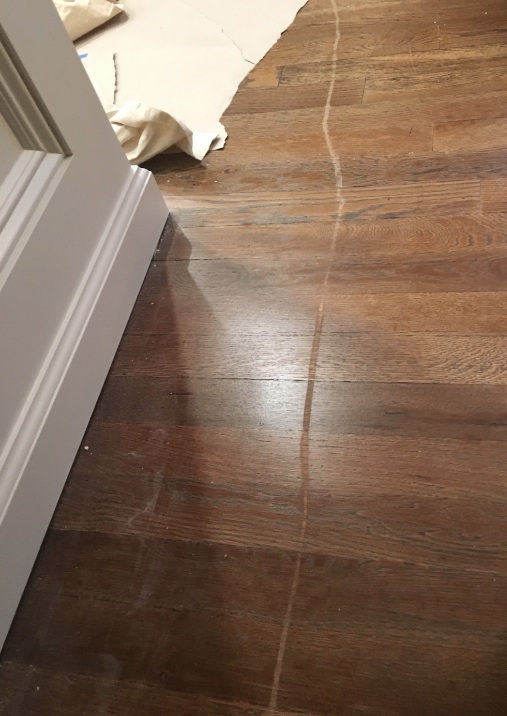
Credit: ronthefloorguy.com
Conclusion: Maintaining The Beauty Of Your Wood Floor
Maintaining the beauty of your wood floor is essential, and knowing how to fix scratches is crucial. With proper care and attention, you can keep your wood floor looking pristine and attractive.
Wood floors can bring warmth and elegance to any space, but over time they can develop scratches and lose their luster. Fortunately, there are several methods to fix scratches and maintain the beauty of your wood floor. In this section, we will recap the different methods to fix scratches, discuss the importance of regular maintenance and prevention, and provide final thoughts on keeping your wood floor in top condition.
Recap Of The Different Methods To Fix Scratches:
- Sanding and refinishing: This method involves removing the top layer of the wood floor, along with the scratches, and applying a fresh coat of finish.
- Wood filler: A wood filler can be used to fill in deep scratches or gouges, providing a smooth surface for refinishing.
- Wax crayon or marker: For minor scratches, using a wax crayon or marker that matches the color of your wood floor can effectively conceal the imperfections.
- DIY remedies: Various household items, such as vinegar and olive oil, can be combined to create a natural remedy to treat minor scratches on your wood floor.
Importance Of Regular Maintenance And Prevention:
- Sweeping and vacuuming: Regularly sweeping or vacuuming your wood floor helps to remove dirt and debris that can lead to scratches.
- Using rugs and mats: Placing rugs and mats in high-traffic areas, especially near entryways, can help prevent scratches by trapping dirt and providing a cushion for foot traffic.
- Felt pads: Applying felt pads to the legs of furniture can prevent scratches caused by moving or sliding them across the wood floor.
- Avoiding high heels and pet’s nails: Encourage family members and guests to remove high-heeled shoes before walking on the wood floor, and keep your pet’s nails trimmed to minimize the risk of scratches.
Final Thoughts On Keeping Your Wood Floor In Top Condition:
- Regular maintenance is key: Implementing a regular cleaning and maintenance routine can help minimize the occurrence of scratches and keep your wood floor looking its best.
- Promptly address any spills or accidents: Wipe up any spills or accidents immediately to prevent moisture from seeping into the wood and causing damage.
- Avoid excessive moisture: Excessive moisture can lead to warping or buckling of the wood floor. Use a damp mop, rather than soaking it, and avoid steam cleaning.
- Professional inspection and maintenance: Periodically seek the assistance of a professional to inspect and maintain your wood floor, ensuring it stays in top condition for years to come.
By following these methods and practicing regular maintenance and prevention, you can enjoy the timeless beauty of your wood floor for many years. Remember, prevention is always better than cure when it comes to keeping your wood floor scratch-free and looking its best.
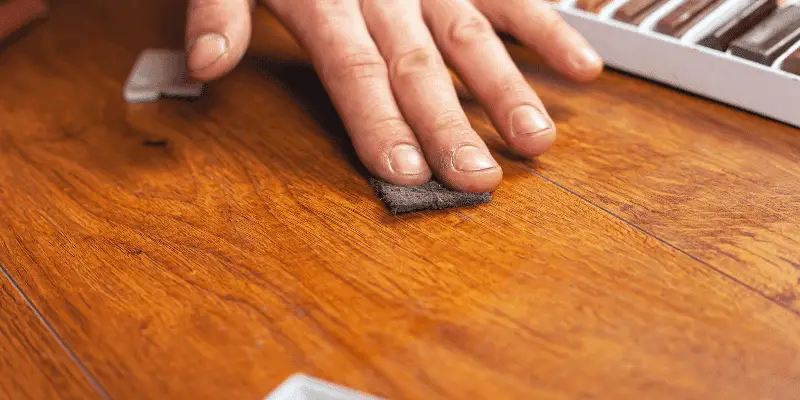
Frequently Asked Questions For How To Fix Scratches On Wood Floor
Can Scratched Wood Floors Be Repaired?
Yes, scratched wood floors can be repaired by using appropriate techniques and products.
How Do You Get Scratch Marks Out Of Wood Floors?
To get scratch marks out of wood floors, gently buff the area with a soft cloth and a mixture of equal parts vinegar and olive oil.
How Do You Repair Dog Nail Scratches On A Wood Floor?
To repair dog nail scratches on a wood floor, follow these steps:
1. Clean the scratched area with a damp cloth.
2. Apply a wood filler that matches the floor color.
3. Smooth the filler with a putty knife and let it dry.
4. Sand the filled area gently and clean the dust.
5. Apply a matching floor finish and let it dry. 6. Finally, buff the repaired area for a seamless look.
How To Fix Gouges Dents And Deep Scratches In Hardwood Floors?
To fix gouges, dents, and deep scratches in hardwood floors:
1. Use wood filler for small imperfections.
2. Sand the damaged area gently with fine-grit sandpaper.
3. Apply stain or finish that matches the floor color.
4. Buff the repaired area to blend it seamlessly with the surrounding floor.
Conclusion
Fixing scratches on a wood floor may seem like a daunting task, but with the right approach, it can be easily manageable. Start by assessing the severity of the scratches and gathering the necessary materials. From there, follow the appropriate method based on the depth of the scratch, whether it’s a simple surface scratch or a deeper gouge.
Remember to always test any products or techniques on a small, inconspicuous area before applying them to the entire floor. By taking preventative measures, such as using rugs or furniture pads, and regularly maintaining the wood floor, you can minimize the occurrence of scratches in the future.
With a little patience and attention to detail, your wood floor can be restored to its former glory.

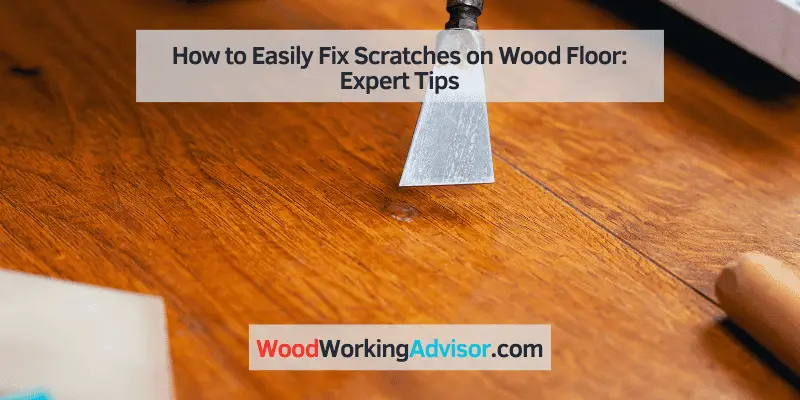

7 thoughts on “How to Easily Fix Scratches on Wood Floor: Expert Tips”